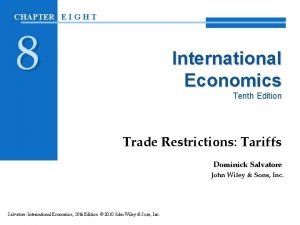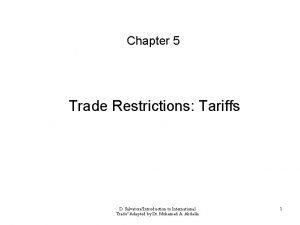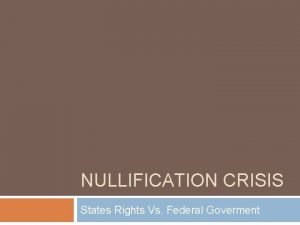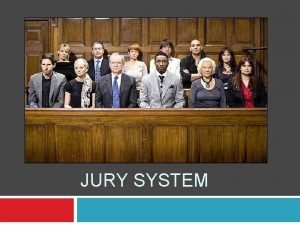Event Tariff Disputes Compromise Tariff of 1833 Nullification



- Slides: 3

Event Tariff Disputes Compromise Tariff of 1833 Nullification Crisis Position of the North wanted high tariffs to protect manufacturing against foreign markets. Position of the South wanted low tariffs Pg 460 -461 Missouri Agreed only because Compromise of Agreed because Maine was admitted Missouri was 1820 as a free state State’s Rights Wilmot Proviso 1846 Compromise of 1850 National govt. should have more power Feared that the South would extend slavery into the West 1. 2. admitted as a slave state. for State Sovereignty State govt. should have more power Believed slavery should be allowed in any territory Effects / Significance Nullification Crisis. National gov would not let the south nullify the act. South Carolina threatened to secede. Key Figures Andrew Jackson John C Calhoun Daniel Webster Banned slavery Henry Clay north of 36 30 line except for MO State sovereignty proved to be weak in the South during the war because it limited authority of the central government Called for a law to ban slavery in any territories won from Mexico. Lincoln Jefferson Davis David Wilmot, a member of Congress from Pennsylvania New Mexico and Utah vote Consisted of 5 parts: Henry Clay on slavery Banned slave trade in Washington -Fugitive slave law California Admitted as free state

Event Fugitive Slave Law, 1850 Position of the North Pg. 465 Position of the South John Brown’s Raid Saw Brown as a hero and martyr Viewed as terrorist act Uncle Tom’s Pg 466 and 467 Cabin by Harriet Beecher Stowe Kansas. Nebraska Act 1854 Outraged because the Missouri compromise already banned slavery north of the 36 30 line Effects / Significance Key Figures Required all citizens to Abolitionists help catch runaway slaves. Slave owners People who let them escape would be fined $1, 000 Led a raid on Harper’s Ferry, VA arsenal. Wanted to help slaves escape by giving them guns to attack John Brown their owners. Failed Robert E Lee attempt. South realized that J. E. B. Stuart the north will go through lengths to stop slavery, so they began putting together an army Pg 466 and 467 Abolitionist who wrote a book that depicted the harsh treatment of slavery. Opened the eyes of many, and became a political issue “ Bleeding John Brown Border Ruffians Kansas” many proslavery They were sure settlers and slave owners anti-slave would move their settlers began slaves to Kansas to attack and to vote for kill each other. slavery. Mini- Civil War

Event Dred Scott v. Sandford 1857 Position of the North South Pg 471 Scott’s Lawyers argued that, because Scott had lived in a free territory, he had become a free man Pg. 471 Rejoiced and were happy because slavery was legal in all territories. 478 Ft Sumter April 11, 1861 Pg 481 Key Figures Supreme court Enslaved- Dred ruled “slaves are Scott property, not people” Further divided the north and south. South Carolina Furious because theyseceded from the thought he would Union December abolish slavery and that 1860. the south would not have any rights. Election of 1860 478 Supported the election, they wanted to abolish slavery and preserve the Union Pg 481 Effects / Significance 1 st shots of Civil War initiated by Believed Fort Could not leave the fortthe Confederacy. Lincoln did not belonged to the Federal in Union Hands government Demanded the union want Union to fire unless fired surrendered upon. Union ran out of supplies - Lincoln -Southern Democrats South Carolina Lincoln and Union Major Robert Anderson Confederate Troops





